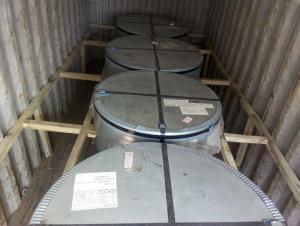Tinplate Coils
- Loading Port:
- China Main Port
- Payment Terms:
- TT OR LC
- Min Order Qty:
- -
- Supply Capability:
- -
OKorder Service Pledge
OKorder Financial Service
You Might Also Like
Tinplate is a thin steel sheet coated by tin. It has an extremely beautiful metallic luster as well as excellent properties in corrosion resistance, solder ability, and weld ability.
Tinplate is widely used for making all types of containers such as food cans, beverage cans, and artistic cans, tea cans, painting cans, chemical package cans and dry food package cans, metal printing etc. Its applications are not limited to containers; recently, tinplate has also been used for making electrical machinery parts and many other products.
Our Tinplates Specification:
Standard: ISO 11949 -1995, GB/T2520-2000,JIS G3303,ASTM A623, BS EN 10202
Material: MR,SPCC
Thickness:0.15mm - 0.50mm
Width: 600mm -1150mm
Temper: T1-T5
Annealing: BA & CA
- Q:Can tinplate be used for packaging of non-food products?
- Yes, tinplate can be used for packaging of non-food products. Tinplate is a versatile material that offers excellent protection against moisture, light, and oxygen, making it suitable for various non-food items such as cosmetics, chemicals, and pharmaceuticals. Its durability and recyclability further make it a popular choice for packaging non-food products.
- Q:How is tinplate coated with tin?
- Tinplate is typically coated with tin through a process called electroplating, where a thin layer of tin is deposited onto the surface of the tinplate using an electric current. This electroplating process helps to protect the iron or steel base of the tinplate from corrosion and also provides a smooth, shiny finish.
- Q:Can tinplate be used for promotional items?
- Yes, tinplate can definitely be used for promotional items. Its versatility, durability, and customizable design options make it a popular choice for creating unique and eye-catching promotional products such as tin boxes, tin signs, tin coasters, and more. Tinplate's ability to be printed with high-quality graphics and logos also allows businesses to effectively showcase their brand and attract attention to their promotional campaigns.
- Q:What are the regulations and standards related to tinplate packaging?
- The regulations and standards related to tinplate packaging vary depending on the country and industry. However, some common regulations and standards include ensuring the tinplate packaging materials are food-grade and safe for consumers, complying with labeling requirements such as product information and warnings, and meeting environmental regulations for packaging waste management. Additionally, tinplate packaging may need to adhere to specific industry standards like those set by the International Organization for Standardization (ISO) or specific regulatory bodies such as the United States Food and Drug Administration (FDA).
- Q:How does tinplate affect the sound quality of musical instruments?
- Tinplate does not directly affect the sound quality of musical instruments. The sound quality primarily depends on the construction, materials, and design of the instrument itself, such as the type of wood used, the shape, and the craftsmanship. Tinplate may be used for aesthetic purposes or as a protective coating, but it does not significantly impact the sound produced by the instrument.
- Q:What are the main applications of tinplate in the sports equipment industry?
- Tinplate is commonly used in the sports equipment industry for various applications such as packaging for tennis balls, protective coatings for golf clubs, and components for hockey sticks. Its corrosion-resistant properties and ability to maintain shape and durability make it an ideal material for ensuring the longevity and performance of sports equipment.
- Q:How does tinplate contribute to the sterility of medical equipment?
- Tinplate contributes to the sterility of medical equipment by providing a protective barrier that prevents the growth of bacteria and other microorganisms. The tin coating on the steel surface of the tinplate acts as a barrier against moisture and oxygen, preventing rusting and corrosion. This not only maintains the integrity of the equipment but also ensures that no contaminants are introduced into the medical environment. Additionally, tinplate is easy to clean and sterilize, further enhancing its contribution to the sterility of medical equipment.
- Q:What are the different methods of joining tinplate components together?
- There are several methods of joining tinplate components together, including soldering, welding, riveting, and adhesive bonding. Each method has its own advantages and is chosen based on factors such as the required strength, aesthetics, and production efficiency of the final assembly.
- Q:Why do tin tins rust easily when they are opened?
- It turned out to be sealed and oxygen has been transpiring. When opening is oxidized (Fe2o3), there is rust.
- Q:What are the main components of tinplate?
- The main components of tinplate are steel and tin.
1. Manufacturer Overview |
|
|---|---|
| Location | |
| Year Established | |
| Annual Output Value | |
| Main Markets | |
| Company Certifications | |
2. Manufacturer Certificates |
|
|---|---|
| a) Certification Name | |
| Range | |
| Reference | |
| Validity Period | |
3. Manufacturer Capability |
|
|---|---|
| a)Trade Capacity | |
| Nearest Port | |
| Export Percentage | |
| No.of Employees in Trade Department | |
| Language Spoken: | |
| b)Factory Information | |
| Factory Size: | |
| No. of Production Lines | |
| Contract Manufacturing | |
| Product Price Range | |
Send your message to us
Tinplate Coils
- Loading Port:
- China Main Port
- Payment Terms:
- TT OR LC
- Min Order Qty:
- -
- Supply Capability:
- -
OKorder Service Pledge
OKorder Financial Service
Similar products
New products
Hot products
Hot Searches
Related keywords



























